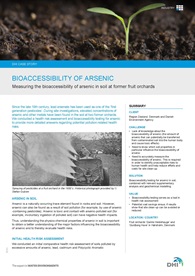Testing the bioaccessibility of arsenic in soil
We conducted a health risk assessment and bioaccessibility testing for arsenic in two former fruit orchards – ‘Gamle Hestehauge’ and ‘Guldborg Have’ – in Hørsholm, Denmark.

We conducted a health risk assessment and bioaccessibility testing for arsenic in two former fruit orchards – ‘Gamle Hestehauge’ and ‘Guldborg Have’ – in Hørsholm, Denmark. In so doing, we helped provide more detailed answers regarding potential pollution-related health risks as well as possible cost savings. Read the case story
here.
Arsenic is a naturally occurring trace element found in rocks and soil. However, arsenic can also be found as a result of soil pollution. This element is toxic and contact with arsenic-polluted soil can have negative health impacts. Thus, understanding the physico-chemical properties of arsenic in soil is important to obtain a better understanding of the major factors influencing the bioaccessibility of arsenic and to thereby evaluate health risks.
Since the late 19th century, lead arsenate has been used as one of the ‘first generation pesticides’. During site investigations, elevated concentrations of arsenic and other metals have been found in the soil at the two abovementioned former orchards. We conducted extensive bioaccessibility testing for arsenic in soil in these orchards and combined this study with relevant supplementary analysis and geochemical modelling.
The results showed that the soil contained more than 20 mg/kgDM of arsenic and arsenate was the dominating species. Results from the bioaccessibility tests also indicated that more than half of the arsenic present in the soil is bioaccessible and suggested that the lower the content of hydrous ferrous oxide (HFO)-reactive surfaces in the soil, the higher the bioaccessibility of arsenic.
Read more